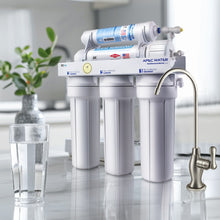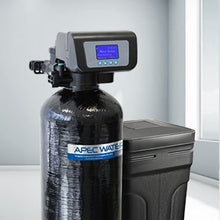A Parent’s Priority
As a parent, we want what is best for our kids. We baby proof outlets, sanitize bottles, and check all the ingredients in their baby formula. However, we rarely notice our water.
The water you use to wash your child's toys, prepare food, or make baby formula may contain harmful contaminants.
Microplastics and PFAs (per- and polyfluoroalkyl substances) are now some of the more common occurring contaminants in household water because they are too microscopic for most water treatment systems to remove.
So how do we protect our family from microplastics and PFAs?
A Reverse Osmosis (RO) filtration system if your answer.
Examining the issue: Protecting Against the Invisible
Microplastics are microscopic particles, usually smaller than 5 millimeters, that leech into our water supply through broken down plastics, fabrics, and packaging. Microplastics are now detected in oceans, rain, bottled water, and even in air. Because of their size, these microplastics slip through most municipal water filtration systems and end up in our household taps.
PFAs, or forever chemicals, are man made chemicals used in water proof coasting, non-stick pans, and cleaning products. PFAs do not degrade easily and can remain in the body for years. Studies have linked PFAs exposure to immune suppression, hormonal imbalances, and developmental effects in infants and children.
Unfortunately, these contaminants are colorless, odorless, and tasteless, which means you can’t detect them without advanced testing. That’s why so many parents are now investing in Reverse Osmosis filtration systems.
Why Purity Matters for Infants
Babies are far more sensitive to environmental contaminants than adults. They consume more water relative to their body weight, especially when fed with formula, and their developing organs are less capable of filtering toxins.
That makes them particularly vulnerable to even trace levels of chemicals and particles in water. While adults might not notice immediate effects, infants can experience greater long-term exposure simply because their bodies are still developing.
Water is important for everything we do:
- Mixing powdered baby formula
- Sterilizing bottles and pacifiers
- Steaming vegetables for homemade baby food
- Preparing baby cereals and purees
- Mixing electrolyte solutions during illness
Each of these activities relies on water as the foundation. Using unfiltered tap water introduces unnecessary risks. Using an RO system to filter your water, you can be sure your baby’s water is free of PFAs, microplastics, heavy metals, and chlorine, providing the cleanest start possible.
The RO Solution: A Molecular Shield
So how does a Reverse Osmosis system purify water and remove PFAs and microplastics?
Reverse Osmosis (RO) is a multi-stage purification process that forces water through a semi-permeable membrane with pores as small as 0.0001 microns. This membrane is smaller than microplastics and PFA molecules, so this means pure water molecules can pass through while impurities are rejected.
What RO Removes:
- PFAs (forever chemicals)
- Microplastics
- Lead, arsenic, and other heavy metals
- Chlorine and chloramines
- Bacteria and viruses
- Pesticides, fluoride, and nitrates
The result is nearly contaminant-free water that’s ideal for your baby’s formula and food preparation. Many parents also report that RO water tastes smoother and cleaner, making it perfect for family use as well.
APEC’s Purity Promise
APEC has specialized in Reverse Osmosis systems proven to deliver lab-grade water quality right from your kitchen faucet.
Why Parents Trust APEC
- NSF-certified filters meet strict safety standards.
- Long filter life (up to 12 months) with easy maintenance.
- Quiet operation and durable construction.
When you choose an APEC RO system, you’re not just filtering water, you’re creating a safeguard for your family’s health, one bottle at a time.
FAQs
Q: Can I use tap water directly for baby formula?
Tap water may meet municipal safety standards, but it can still contain microplastics, PFAs, and other trace contaminants. Using RO-filtered water ensures your baby’s formula is made with the purest water available.
Q: Does RO filtration remove PFAs and microplastics?
Yes. Reverse Osmosis membranes are fine enough to remove even microscopic particles and chemical compounds, including PFAs (“forever chemicals”) and microplastics, delivering near-zero contaminant levels.
Q: Is an RO system a better investment than bottled water for my baby?
Absolutely. Bottled water can still contain microplastics from packaging and costs far more over time. An APEC RO system provides safer, fresher, and more economical water.



